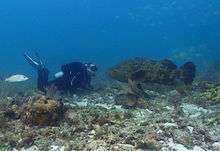Atlantic goliath grouper
| Atlantic goliath grouper | |
|---|---|
| | |
| Scientific classification | |
| Kingdom: | Animalia |
| Phylum: | Chordata |
| Class: | Actinopterygii |
| Order: | Perciformes |
| Family: | Serranidae |
| Genus: | Epinephelus |
| Species: | E. itajara |
| Binomial name | |
| Epinephelus itajara (Lichtenstein, 1822) | |
The Atlantic goliath grouper or itajara (Epinephelus itajara) is a large saltwater fish of the grouper family found primarily in shallow tropical waters among coral and artificial reefs at depths from 5 to 50 m (16 to 164 ft). Its range includes the Florida Keys, the Bahamas, most of the Caribbean, and practically all of the Brazilian coast. On some occasions, it is caught in New England off Maine and Massachusetts. In the eastern Atlantic Ocean, it occurs from the Congo to Senegal.
Description
Young Atlantic goliath grouper may live in brackish estuaries, oyster beds, canals, and mangrove swamps, which is unusual behavior among groupers.

They may reach extremely large sizes, growing to lengths up to 2.5 m (8.2 ft) and can weigh as much as 360 kg (790 lb). The world record for a hook-and-line-captured specimen is 309 kg (681 lb), caught off Fernandina Beach, Florida, in 1961.[2] They are usually around 180 kg (400 lb) when mature. Considered of fine food quality, Atlantic goliath grouper were a highly sought-after quarry for fishermen. The grouper's inquisitive and generally fearless nature makes it a relatively easy prey for spear fishermen. They also tend to spawn in large aggregations, returning like clockwork to the same locations, making them particularly vulnerable to mass harvesting.
Until a harvest ban was placed on the species, its population was in rapid decline. The fish is entirely protected from harvest and is recognized as a critically endangered species by the IUCN.[1] The US began protection in 1990, and the Caribbean in 1993. The species' population has been recovering since the ban; with the fish's slow growth rate, however, some time will be needed for populations to return to their previous levels.
Goliath grouper eat crustaceans, other fish, octopuses, young sea turtles, sharks, and barracudas. They are known to attack divers, and have even been seen attacking large lemon sharks.
Reproduction
Goliath groupers are believed to be protogynous hermaphrodites, which refer to organisms that are born female and at some point in their lifespans change sex to male. Most grouper follow this pattern, but this has not yet been verified for the goliath.[3] In fact, males could be sexually mature at smaller sizes (about 115 cm) and younger ages (4–6 years) than females (about 125 cm and about 6–8 years).[4]
Conservation
In May 2015, the Atlantic goliath grouper was successfully bred in captivity for the first time. [5][6][7]
Parasites
As other fish, the Atlantic goliath grouper is the host of several species of parasites, including the diplectanid monogenean Pseudorhabdosynochus americanus on its gills.[8]
Terminology
The Atlantic goliath grouper has been referred to as the jewfish, but in 2001, the American Fisheries Society stopped using that term because they felt that it was "culturally insensitive".[9]
References
- 1 2 Craig, M.T. (2011). "Epinephelus itajara". IUCN Red List of Threatened Species. Version 2013.2. International Union for Conservation of Nature. Retrieved 30 March 2014. Database entry includes a range map and a lengthy justification of why this species is critically endangered
- ↑ IGFA World Records
- ↑ "FLMNH Ichthyology Department: Goliath Grouper". Flmnh.ufl.edu. Retrieved 2011-10-31.
- ↑ Bullock et al. (1992). Age, Growth, and Reproduction of Jewfish Epinephelus itajara in the Eastern Gulf of Mexico. U.S. Fishery Bulletin 90 (2):243-249. Retrieved August 21, 2014.
- ↑ http://www.eltiempo.com/colombia/otras-ciudades/en-cartagena-logran-reproducir-en-cautiverio-al-pez-mero-guasa/15989735
- ↑ http://www.eltiempo.com/estilo-de-vida/ciencia/colombianos-logran-salvar-al-mero-guasa-de-la-extincion/15990678
- ↑ http://fis.com/fis/worldnews/worldnews.asp?monthyear=6-2015&day=23&id=77398&l=s&country=&special=&ndb=1&df=0
- ↑ Kritsky, Delane C.; Bakenhaster, Micah D.; Adams, Douglas H. (2015). "Pseudorhabdosynochus species (Monogenoidea, Diplectanidae) parasitizing groupers (Serranidae, Epinephelinae, Epinephelini) in the western Atlantic Ocean and adjacent waters, with descriptions of 13 new species". Parasite 22: 24. doi:10.1051/parasite/2015024. ISSN 1776-1042. PMC 4536336. PMID 26272242.

- ↑ Brassfield, Mike (May 24, 2001). "Big fish get a giant name". St. Petersburg Times. Retrieved August 21, 2014.
External links
| Wikimedia Commons has media related to Epinephelus itajara. |
- Florida Museum of Natural History description including alternate names
- Atlantic goliath grouper at the Encyclopedia of Life
- Froese, Rainer and Pauly, Daniel, eds. (2004). "Epinephelus itajara" in FishBase. October 2004 version.
| ||||||||||||||||||||||||||||||||||||||||||||||||||||||||||||||||||
